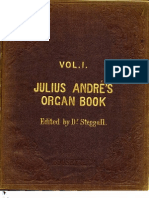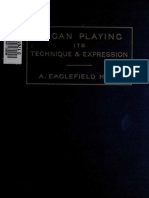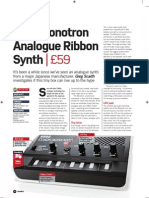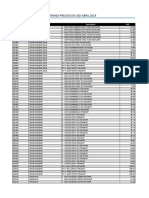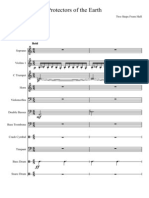Beginning Organ
Beginning Organ
Uploaded by
Rogerio LimaCopyright:
Available Formats
Beginning Organ
Beginning Organ
Uploaded by
Rogerio LimaCopyright
Available Formats
Share this document
Did you find this document useful?
Is this content inappropriate?
Copyright:
Available Formats
Beginning Organ
Beginning Organ
Uploaded by
Rogerio LimaCopyright:
Available Formats
Beginning Organ
Dan Miller
Beginning Organ
Quick! I have to play the organ! What do I do?
Relax! Im here to help you! This workshop is designed as a 1-hour heres how to get
started coaching session, aimed for the non-organist (pianist or keyboardist) who is
requested to play the organ with very little advance notice.
This workshop will cover the very basics of the organ and how to play it.
Workshop overview:
1. Quick tour of the organ console
2. Stops
3. Pistons
4. Expression and Crescendo Shoes
5. Basic registration suggestions
6. Basic organ playing techniques
7. Easy organ music suggestions
8. Resources for more information
9. Lets get acquainted
2
1. QUICK TOUR OF THE ORGAN CONSOLE
1a. Console Map
Stops
(organ voices)
Thumb pistons
(preset stop
combinations)
Toe pistons,
also called
Toe Studs
(preset stop
combinations)
Shoes
Pedalboard
Swell manual
(upper keyboard)
Great manual
(lower keyboard)
Choir manual
(bottom keyboard)
Great manual
(middle keyboard)
Swell manual
(upper keyboard)
Stops
(organ voices)
3
1b. Console Controls
4
2. STOPS
Tab stops Drawknob stops
2a. What is a stop?
The term stop is used to describe a single voice on an organ, such as Principal 8, Clairon 4,
Mixture IV, etc. A stop sound will be heard if it is activated and keys or pedals which control it
are also activated. For example, the Principal 8 stop in the Great division will sound if it is
activated and notes are played on the Great manual.
2b. How to turn on/off a stop
To activate a stop, press the bottom half of the rocker tablet until it lights, and release (or pull the
drawknob and release). To silence a stop, press the top half of the rocker tablet until the light
goes off, and release (or push the drawknob and release).
!
Stops can be cleared quickly by pressing the General Cancel piston, (labeled 0)
located on the right-hand side under the bottom keyboard. Simply press and release
this piston to cancel a registration.
2c. Stop Families of Sound Character
Organ stops are grouped into four main families: Principals, Flutes, Strings and Reeds.
The Principal family is the group of stops which are unique to the organ, they arent imitative of
other instruments. Principals are often referred to as the backbone of the organ and play a
strong role in hymn accompaniments and as the foundation of many chorus registrations.
Examples of stops belonging to the Principal family are Principal, Octave, Super Octave,
Choralbass and Prestant.
The Flute family consists of stops which are generally imitative of orchestral flutes and
recorders. This is an extremely diverse group of stops which function in a myriad of ways, from
acting as a solo color to serving as the basis of ensemble registrations, either by themselves or in
combination with other stops. Examples of flute stops are the Rohrflte, Flauto Traverso and
Spitzflte.
5
String stops do exactly what you would imagine they imitate the sound of orchestral strings.
These ranks are smaller in scale than most other ranks and usually have a lot of upper harmonics
and a clean or silvery timbre. This characteristic makes them well suited to accompaniment
and softer ensembles. String stops include the Viole Celeste II. Other stops which are a cross
between a String and Flute color are the Erzhler and Gemshorn.
Members of the Reed family are also very diverse and are used for everything from solo colors
to the fiery crown in a full organ registration. These stops, also, are often imitative of orchestral
reeds. Examples of reed stops are the Trompette, Hautbois and Cromorne.
2d. Other Families
The Percussion family contains voices such as the Chimes and Harpsichord. These stops have
a percussive attack and gradually grow softer as you hold the note.
Also present in Rodgers organs are voices in the Orchestral and Choral families. Examples of
Orchestral colors include the Strings and Slow Strings; Choral voices are represented by SATB
Oo and SATB Ah stops.
2e. The number on the stop shows its pitch.
The stops and couplers on the organ each have a pitch designation, listed in feet, (8, 4, 16,
etc.). 8 refers to concert pitch; a note played on an 8 stop will have an identical pitch as the
same note played on a piano. 16 represents an octave below concert pitch; a note played on a
16 stop will sound an octave below an 8 stop.
This system of designating pitches represents the approximate length of open organ pipes; the
largest pipe in an 8 rank is approximately eight feet long; the largest pipe in a 16 rank is about
sixteen feet long. Other footages and their relationship to concert pitch are listed in the table
below:
Pitch Relationship to concert pitch
32 two octaves below
16 one octave below
8 equal to concert pitch (also known as Unison)
4 one octave above
2 two octaves above
1 three octaves above
6
2f. Fraction? Its a Mutation stop.
Mutation stops have fractions in their pitch designations. This means that their pitch falls
somewhere other than on the octave. (Refer to the table below).
Mutation Common name Relationship to concert pitch
2-2/3 Nazard one octave and a fifth above
1-3/5 Tierce two octaves and a third above
1-1/3 Larigot two octaves and a fifth above
Mutations are most commonly from the flute family and are often used with other flute stops in
solo registrations or ensembles used in early organ music. Because mutations often appear in
divisions with a number of other flute stops, a great diversity of solo color can be achieved by
using various combinations of stops. See the following table for common solo registrations
utilizing mutations.
Common Registrations for a Solo Melody Using Flute Stops and Mutation Stops
8
flute
4
flute
2-2/3 2
flute
1-3/5 1-1/3
Larger organs may have one or two mutation stops from the principal family. In most cases,
these ranks are used to add color to the principal chorus.
2g. Roman Numeral? Its a Mixture stop.
Mixture stops are easily identified because of a Roman numeral. Common mixture stop names
could be Fourniture, Mixture and Plein Jeu. Mixtures consist of multiple Principal ranks; the
Roman numeral following the name denotes the number of ranks contained in the mixture. For
example, a Mixture IV stop contains four ranks of Principal pipes. (A rank is a distinct set of
pipes. Most stops consist of one rank of 61 pipes = one pipe per keyboard note. A four-rank
mixture would have 4 pipes playing on each note.)
7
2h. Celeste stops
Celestes are unique among organ stops in that they are intentionally tuned sharp or flat in relation
to the rest of the instrument. Celestes are paired with a partner stop (often called a unison)
which is similar in color to the celeste stop but is in tune with the balance of the organ. When the
unison and celeste are drawn together, the tuning discrepancy between the two stops creates a
beautiful undulating quality suitable for lush, romantic textures. Celestes are either from the
string or flute family, with the latter usually being the quieter of the two.
!
TRY THIS: Listen to each stop on your organ individually. Hold a chord or a key and
turn on and off each stop, one by one. Listen for its character (identify which family
does it belong); listen for its strength (loud/soft); listen for its pitch. Most
importantly, learn and remember which stops are the softest and the loudest.
2i. Tremulants
If your organ has no stops on, but you turn on a Tremulant and play a key, you will hear nothing.
Tremulants create a wavy sound to organ stops already turned on. Actually, tremulants change
the pitch (sharp and flat), amplitude (volume) and timbre (tone quality). The use of the tremulant
adds warmth and expressiveness to solo or small ensemble combinations. It is not common to
use tremulants in larger classical ensembles. In some romantic ensembles, tremulants are used
judiciously. In some gospel and evangelical musical traditions, tremulants with a wider and
deeper excursion are frequently used.
There are two types of tremulant controls; divisional tremulants which affect only the stops in
their respective division and general tremulants which affect all divisions.
2j. Couplers (i.e. Swell to Great 8)
If your organ has no stops on, but you turn on a coupler and play a key, you will hear nothing. A
Coupler is a control which allows a division of the organ to be played from a different manual.
For example, by activating the Swell to Great coupler, you could play stops in the Swell
division from the Great manual. (Swell to Great literally means, connect the Swell division to
the Great manual).
Couplers allow you to control a larger portion of the organ from one manual or the pedalboard
and are useful in achieving larger or more varied registrations.
8
3. PISTONS
3a. Using Pistons to Select Registrations
Combinations of stops and couplers are referred to as registrations.
Obviously, once youve found a desirable registration, youll want to be able to recall it quickly
and easily. This is done through the combination action of the organ.
The combination action is comprised of pistons, each of which can store a combination of stops,
couplers and other settings. These pistons are located beneath the manuals of the organ
(commonly referred to as thumb pistons) or on the kneeboard to the left and right of the
expression shoes (commonly referred to as toe pistons).
Pressing a piston with your thumb or foot will cause its stored registration to be recalled
instantly.
Each of the available pistons in the combination action can be easily changed to suit your
particular needs and tastes.
3b. Using 0 to Cancel Registrations
Stops and couplers can be cleared quickly by pressing the General Cancel piston, (labeled 0)
located under the bottom manual on the right-hand side of the keyboard. Simply press and
release this piston to cancel a registration.
3c. General and Divisional Pistons
Most organs have two different types of pistons, general and divisional pistons. General pistons
affect the entire organ, while divisional pistons affect a single division. For example, you could
use a single general piston to recall stops, couplers and MIDI settings on every division at once,
or you could use a Swell divisional piston to change the Swell alone.
General pistons are located on thumb pistons under the left-hand side of the Great and Swell
manual. In addition, they are duplicated on toe pistons to the left of the expression shoes.
To recall a registration stored on a general piston, you could press either the corresponding
thumb piston or toe piston; in other words, to select general piston 7, you could either press
thumb piston 7 under the Swell manual or toe piston 7 on the kneeboard. This duplication of
pistons allows you to use either your thumb or foot to recall the same registration, depending on
what is most convenient.
Divisional pistons for the Great, Swell, and Choir are located under the corresponding manual.
For example, Great divisional pistons are located underneath the Great manual near the middle
of the keyboard.
Pedal divisional pistons can be thumb pistons but more commonly are only available as toe
pistons.
General pistons affect the entire instrument. Use these pistons when you want to affect all stops
and couplers with a single control.
9
Divisional pistons work well when you want to affect only a single division. For example, if you
want to change stops in the Swell without affecting the rest of the instrument, you could use a
Swell divisional to change only the Swell registration.
Refer to the next illustration for the location of general and divisional pistons.
10
3d. How to Set a Piston
To set a new registration on a piston:
1. Select the desired stops, couplers and MIDI settings.
2. Press and hold the SET piston, located on the left hand side under the Great
manual.
3. While continuing to hold SET, press the piston to be programmed.
4. Release both pistons. The new registration is now stored.
3e. Tutti
There are times when a full organ registration is needed immediately. The Tutti thumb piston
allow you to engage full organ quickly without canceling the registration which is set.
To activate Tutti, press TUTTI. As this is a reversible control, simply press it again to turn Tutti
off and return to the current registration.
When Tutti is activated, the Tutti indicator located directly above the Crescendo indicator is lit.
Pressing General Cancel (0) will cancel Tutti.
3f. Memory Levels
The Rodgers consoles advanced combination action has four (or more) memory levels,
effectively multiplying the number of available combination pistons by four. These pistons are
labeled M1, M2, M3 or M4. Pistons stored on one memory level dont affect those stored on
other memory levels; each of the memories is independent.
Many organists keep regularly used registrations, such as those used for hymns, on one memory
and use other memory levels for preludes, postludes and choral accompaniments, which may
change week to week.
To select a memory level:
1. Press the corresponding memory piston (M1, M2, M3 or M4). It will light.
When the organ is powered on, M1 is automatically selected.
!
Rodgers SmartCard Memory System gives you unlimited memory levels! Over 100
Memory Levels can be saved to a Smart Media Card inserted into the organ. Use
individual Smart Media Cards for multiple organists, organ students, etc.
11
4. EXPRESSION AND CRESCENDO SHOES
4a. Expression Shoes
The Rodgers console has two expression shoes which are used to control the volume of the
organ. The left shoe normally controls the volume of the Choir, Great and Pedal divisions and
the middle shoe controls the volume of the Swell division.
When an expression shoe is pressed forward, the volume of the division increases; when the shoe
is drawn back, the volume of the division decreases. The position of the two expression shoes are
displayed on two expression indicators, located on the right-hand side of the coupler rail.
4b. Crescendo Shoe
The slightly raised shoe on the right is the Crescendo shoe. This shoe gradually adds a preset
selection of stops as it is pressed forward. It does not affect the stops already in use on the organ
but merely adds to them as the Crescendo is activated. Closing the Crescendo shoe subtracts the
stops in reverse order.
Stops added by the Crescendo shoe do not light as they are activated. A Crescendo indicator
which shows the position of the Crescendo shoe is located on the right-hand side of the coupler
rail next to the two expression indicators.
12
5. BASIC REGISTRATION SUGGESTIONS
Listed here are five basic organ registrations for church use, particularly for choral
accompaniment and hymn playing. ALWAYS listen to your selection of stops and adjust your
registration for proper level of volume and balance. You may wish to set these registrations to
General Pistons 1-5.
Purpose Pedal Swell Great Choir
1. Very Soft The softest 16 stop The softest 8 stop
(no reeds) (celeste
stop OK)
Softest 8 stop
(celeste stop OK)
Swell to Great 8
Choir to Great 8
The softest 8 stop
(no reeds) (celeste
stop OK)
Swell to Choir 8
2. Soft Softest 16
Maybe softest 8 ?
Maybe Swell to Pedal
8 ?
Two softest 8 stops
(no reeds) (celeste
stops OK)
Two or three softest
8 stops (no reeds)
(celeste stops OK)
Swell to Great 8
Choir to Great 8
Two softest 8
stops
(no reeds) (celeste
stops OK)
Swell to Choir 8
3. Medium Two of the softest 16
stops
8 stops
(no reeds)
Swell to Pedal 8
All 8 and 4 stops
except reeds and
celestes.
All 8 and 4 stops
except reeds and
celestes.
Swell to Great 8
Choir to Great 8
All 8 and 4 stops
except reeds and
celestes.
Swell to Choir 8
4. Medium-Loud All 16, 8 and 4
stops except reeds
All 8, 4, 2 stops
except reeds and
celestes.
All 8, 4, 2 stops
except reeds and
celestes.
Swell to Great 8
Choir to Great 8
All 8, 4, 2 stops
except reeds and
celestes.
Swell to Choir 8
5. Loud All 16, 8 and 4
stops except reeds.
32 stop if available.
Swell to Pedal 8
Great to Pedal 8
All 8, 4, 2 stops
except reeds and
celestes.
Mixture.
All 8, 4, 2 stops
except reeds and
celestes.
Mixture.
Swell to Great 8
Choir to Great 8
All 8, 4, 2 stops
except reeds and
celestes.
Mixture (optional)
Swell to Choir 8
A louder level of registration above #5 would be the TUTTI piston, which means full organ.
13
6. BASIC ORGAN PLAYING TECHNIQUES
It is presumed that you already have a basic foundation of music reading, keyboard knowledge
and skill. The techniques below are quick helps for a situation where a non-organist (pianist or
keyboardist) is requested to play the organ with very little advance notice.
6a. Posture
Sit in the middle of the bench. The bench should be positioned (forward or back) so you can
reach the expression shoes and pedals comfortably. Make sure the bench is positioned evenly
straight with the organ console. If the bench has a backrest, you should not lean against the
backrest as you play the organ.
6b. Keyboard technique
Playing the organ keyboards is similar to playing a keyboard (synthesizer). Unlike playing a
piano, the notes most often should be more connected. However, if the music is rhythmic,
detached playing could be more appropriate. Breathe with the music. For example, lift the
keys momentarily when a singer would breathe (especially for a hymn).
6c. Pedal technique
Play the bass note of the chord or harmonic structure on the pedal, using your left foot.
!
Of course, the best organ training is to have one-on-one lessons with an organ
instructor.
14
7. EASY ORGAN MUSIC CHURCH REPERTOIRE
SUGGESTIONS
These are some suggestions. Browse thru easy organ music offered at the exhibits and
workshops at this convention!
He Leadeth Me Dorothy Wells Lorenz 70/1247L
Hymns for the New Organist Gayden C. Sikes Genevox 0767317416
Music for Manuals General & Fall Festivals compilation MorningStar Mus Pub MSM-10-558
Music with Minimal Pedal General & Fall
Fest.
compilation MorningStar Mus Pub MSM-10-559
Our Faith Eugene McCluskey Lorenz 70/1243L
Unending Carols Tim Doran Lillenas MC-276
Unending Comfort Tim Doran Lillenas MB-687
Unending Hymns Tim Doran Lillenas MB-653
Unending Love Tim Doran Lillenas MB-756
Unending Praise Tim Doran Lillenas MB-652
Unending Praise II Tim Doran Lillenas MB-693
Wedding Music for Manuals Ed. Charles Callahan Concordia Pub House 97-6427
Anything published by Frog Music Press! See www.frogmusic.com
15
8. RESOURCES FOR MORE INFORMATION
Websites
Web chat group, resources for Rodgers organs and the PR300S sequencer/sound
module: www.frogmusic.com
American Guild of Organists educational resources: www.agohq.org
Organ Historical Society www.ohscatalog.org (see below)
Search the web for books, videos, computer educational programs, etc.
Books
Suggestions from www.ohscatalog.org:
Wayne Leupold (ed.): First Organ Book For a First Encounter with the Organ! Concise and entirely
accessible, this excellent book presents an introduction to the organ, a beginning organ method, and a collection of
easy organ music. Designed as a primary teaching resouce for the AGO Pipe Organ Encounters, the compositions
enable the keyboardist with minimal technique to sound well immediately, after three years of traditional piano study.
97 pages, softbound.
Joyce Jones: King of Instruments: A Short Method This 72-page, short, easy organ method for pianists
"will get them playing as rapidly as possible." Study pieces can be used in church, and hymn playing is emphasized.
Joyce Jones: Pedal Mastery for Organ a method book for pedal study with technique clearly explained and
reinforced with exercises, many taken from standard organ works.
OrganTutor Organ 101 by Don Cook. An interactive, multi-media, computer-based resource for classical and
traditional sacred organ instruction. OrganTutor serves as a teaching assistant for basic organ playing in 62
lessons, making use of old technologies and the new technology of your computer. Movies and/or sound examples
are included in most lessons. The sound examples may either play through the speakers of your computer or through
a MIDI interface to the organ. Youll need a Power Mac or Pentium with PC at least 16 MB RAM, sound card with
MIDI interface, and CD-ROM 4x or better. The Tutor is an aid to instruction and not a replacement for an organ
instructor. Dr. Cook is organ instructor at Brigham Young University. Includes software and instruction book.
Roger E. Davis: The Organists Manual Scholarly and user-friendly, this method has much to offer the
beginner and the experienced professional. Included are sections on manual technique, pedal technique,
interpretation, and useful appendices: hymn playing, a well-illustrated and clearly-written description of the organ, a
glossary, and suggestions for further reading. Exercises and examples are practical, interesting, and drawn from
established organ literature. Extensive and very helpful sections address principles of fingering and ornamentation.
Sixty-six compositions are progressively arranged according to difficulty in a superb anthology by 42 composers
representing a broad variety of styles and periods. Registration suggestions are provided for each work. A thoughtful
selection of hymn tunes for study completes this highly recommended and versatile book. Hardbound, 209 pages.
James Engel: An Introduction to Organ Registration The author builds a foundation for understanding the
classification of organ stops both by pitch (16', 8', 4', etc.) and by timbre (principal, flute, string, reed, etc.). He also
deals with mechanical devices such as swell shutters, tremulants, crescendo pedal, etc. An appendix shows the
shape of each type of organ pipe. The concepts presented are applied to specific musical examples.
David M. Cherwien: Let the People Sing! A Keyboardists Creative and Practical Guide to
Engaging Gods People in Meaningful Song by David M. Cherwien. Useful to the most and least
experienced church organists and everybody in-between, this practical manual is an extended masterclass in leading
congregational singing from the keyboard. Many good observations and suggestions are followed with plentiful
examples, creating a manual that you will return to again and again if you seek to improve your performance as an
accompanist and the congregations role as singers. 179 pp.
16
17
9. LETS GET ACQUAINTED
In considering the scope of Dan Millers gifted career,
one finds it embraces the entire gamut of musical artistry.
He is internationally renowned as a pianist, organist,
harpsichordist and keyboardist. He has taught music,
conducted choral groups and orchestras, led and
facilitated worship in many different settings, and
managed large concert productions and music
conferences. He is also respected as an innovative leader
in handbells. A professional member of ASCAP, Mr.
Miller is renowned for his composing and arranging, and
has several published works to his credit. He has been
seen and heard live in concert and through recordings on
radio, television, and the internet. He has been the
featured solo organist with several Symphony Orchestras.
He is a past-dean of the Ft. Lauderdale chapter of the
American Guild of Organists. Mr. Miller holds the
distinguished position of Product Manager and Design
Manager of Four-Manual Custom Organs at Rodgers
Instruments LLC, one of the worlds leading organ
builders, in Hillsboro, Oregon.
A church organist since age fifteen, Dan Miller has
served at several notable churches. At Calvary Church in
Charlotte, North Carolina, he presided over the worlds
thirteenth largest pipe organ; at Coral Ridge Presbyterian
Church, Fort Lauderdale, Florida, he served as assistant
organist to Diane Bish. Currently Dan is the Organist for
two churches in Beaverton, Oregon: St. Matthew
Lutheran Church and Beaverton Christian Church. He
also serves many churches nationwide as Guest Organist
for their worship services.
Mr. Miller holds a Church Music Diploma from Moody Bible Institute. He majored in organ performance at the
American Conservatory of Music, holds a Bachelor of Fine Arts degree from Florida Atlantic University, and a
Master of Music degree in Organ Performance from Winthrop University.
Mr. Miller has recorded eleven organ compact discs, of which some selections have been broadcast on National
Public Radios Pipedreams. His first CD, The Calvary Organ Dedication, was chosen as The Organ CD to Die
For by Stereophile magazine in its February 1994 issue. He continues to enjoy his work with teams and
committees as consultant and advisor in designing heroic grand organs of world-class significance and preeminence.
Dan and his wife live in Hillsboro, Oregon. They have two daughters.
For more information about Dan Miller, please visit his website: www.DanMillerMusic.com
. . . There is the added joy of having [the Calvary Grand Organ] presided over by one of the finest of the
young organists of the generation. Dan Miller is not only vastly musical and superbly gifted, but he
understands this magnificent new instrument and uses it to its fullest potential. I urge you to hear this
unbeatable combination . . .
The American Organist, April 1991
www. DanMi l l er Musi c. com
dmiller@rodgers.rain.com 503.681.6544 Rodgers Instruments LLC 1300 NE 25
th
Ave, Hillsboro, OR 97124
18
You might also like
- Flor Peeters - Organ Book PDFDocument122 pagesFlor Peeters - Organ Book PDFLouie Angelo Oca100% (9)
- Dupre, Marcel - Method For The OrganDocument81 pagesDupre, Marcel - Method For The OrganEdgar Bablumyan100% (22)
- Complete Organ Method: A Classic Text on Organ TechniqueFrom EverandComplete Organ Method: A Classic Text on Organ TechniqueRating: 4.5 out of 5 stars4.5/5 (2)
- (Cambridge Companions To Music) Nicholas Thistlethwaite, Geoffrey Webber (Eds.) - The Cambridge Companion To The Organ-Cambridge University Press (1998) PDFDocument355 pages(Cambridge Companions To Music) Nicholas Thistlethwaite, Geoffrey Webber (Eds.) - The Cambridge Companion To The Organ-Cambridge University Press (1998) PDFגיא שפירא100% (5)
- Lanquetuit - Toccata in D 2.0Document7 pagesLanquetuit - Toccata in D 2.0theotdf25% (4)
- Marcel Dupré: Manuel D'accompagnement Du Plain Chant Grégorien Accompagnement Chant GrégorienDocument42 pagesMarcel Dupré: Manuel D'accompagnement Du Plain Chant Grégorien Accompagnement Chant GrégorienIvan Pierre100% (10)
- Gubaidulina, Sofia - Glorious Percussion PDFDocument123 pagesGubaidulina, Sofia - Glorious Percussion PDFJorge CareNo ratings yet
- Mini ScoreDocument13 pagesMini ScoreNelson Carapinha VazNo ratings yet
- Idiots Guide To Organ RegistrationDocument8 pagesIdiots Guide To Organ RegistrationJoshuaNichols100% (4)
- The CompleteTHE COMPLETE CHURCH ORGANIST Church OrganistDocument62 pagesThe CompleteTHE COMPLETE CHURCH ORGANIST Church OrganistColleen Van Schalkwyk100% (10)
- Organ Registration - 272-Pages - Comprehensive Guide by Everette E Trudette - 1919Document272 pagesOrgan Registration - 272-Pages - Comprehensive Guide by Everette E Trudette - 1919Church Organ Guides100% (13)
- Guilmont Practical Organist BK 1Document118 pagesGuilmont Practical Organist BK 1Bridget O'Leary100% (18)
- Christmas Music For The OrganDocument48 pagesChristmas Music For The OrganJuanma Santos100% (24)
- Improvisation On The OrganDocument69 pagesImprovisation On The Organppiccolini100% (23)
- The Liturgical Organist - The Creative Use of Solo Organ Music inDocument77 pagesThe Liturgical Organist - The Creative Use of Solo Organ Music inredlandadamNo ratings yet
- Pachelbel Organ WorksDocument253 pagesPachelbel Organ WorksIbrahim Merel100% (1)
- Marcel Dupré PDFDocument214 pagesMarcel Dupré PDFAndré Bandeira100% (1)
- Vox VT-Cheat SheetDocument1 pageVox VT-Cheat Sheetstereomati3751No ratings yet
- Awitin Mo at Isasayaw Ko - BASS TABDocument6 pagesAwitin Mo at Isasayaw Ko - BASS TABgeraldgfloresNo ratings yet
- For The Beauty of The Earth Brassband Score - BakDocument20 pagesFor The Beauty of The Earth Brassband Score - Bakdudaxavier33% (3)
- By U Organ Workshop Packet 2017Document34 pagesBy U Organ Workshop Packet 2017Adrian100% (7)
- On Organ Playing - Hints to Young Organists, with Complete Method for Pedal Scales and ArpeggiosFrom EverandOn Organ Playing - Hints to Young Organists, with Complete Method for Pedal Scales and ArpeggiosRating: 3 out of 5 stars3/5 (1)
- Teach The OrganDocument44 pagesTeach The Organmauro9601595100% (4)
- The Technique and Art of Organ Playing (Dickinson, Clarence)Document276 pagesThe Technique and Art of Organ Playing (Dickinson, Clarence)Ambroise100% (9)
- Julius Andre's Organ BookDocument90 pagesJulius Andre's Organ Bookmontuno86% (7)
- Transformations-Preludes and PostludesDocument39 pagesTransformations-Preludes and PostludesOskr ArTuro100% (3)
- Church Music - The Pastoral OrganistDocument9 pagesChurch Music - The Pastoral OrganistDennis50% (10)
- Archer-12 Organ Preludes Op2Document61 pagesArcher-12 Organ Preludes Op2Jerald Franklin Archer100% (7)
- Hymn Accompaniment - Organ Playing - HullDocument286 pagesHymn Accompaniment - Organ Playing - HullChurch Organ Guides96% (28)
- Organ RegistrationDocument7 pagesOrgan RegistrationErma Sandy LeeNo ratings yet
- Organ MusicDocument137 pagesOrgan Musicantonio valdez100% (4)
- An Explanation of Organ Stops - Locher - 100-Pages - 1888Document100 pagesAn Explanation of Organ Stops - Locher - 100-Pages - 1888Church Organ Guides91% (11)
- Buck - Vox Organi PDFDocument138 pagesBuck - Vox Organi PDFAndreaMeroni100% (1)
- Bach's Organ Registration - W. SumnerDocument83 pagesBach's Organ Registration - W. Sumnercedric100% (5)
- Manual OrganistaDocument27 pagesManual OrganistaCarmelo Hoyos100% (3)
- Hymn Accompaniment - Richards - 1911Document208 pagesHymn Accompaniment - Richards - 1911Church Organ Guides89% (36)
- L'Organiste - CompilationDocument67 pagesL'Organiste - Compilationrichime1796% (23)
- Luebeck Vincent ORGAN WORKSDocument55 pagesLuebeck Vincent ORGAN WORKSIvan Rakonca100% (4)
- Organ Works - V. LubeckDocument57 pagesOrgan Works - V. LubeckAlessio Carrus100% (4)
- Saint Peter S Postlude For OrganDocument10 pagesSaint Peter S Postlude For OrganDavid Garrison100% (3)
- The Wanamaker Grand Organ PDFDocument18 pagesThe Wanamaker Grand Organ PDFAfonso24No ratings yet
- Bach CPE Organ MusicDocument85 pagesBach CPE Organ Musicphroddy100% (6)
- Liturgical Organ Music WEBDocument330 pagesLiturgical Organ Music WEBФёдор Скопин100% (3)
- BOSSI REDEMPTION ORGAN SoloDocument7 pagesBOSSI REDEMPTION ORGAN Solomusiccentersf100% (1)
- Organ BookDocument23 pagesOrgan BookMyc-lNo ratings yet
- Hymn Accompaniment - Reed Organs - 1910Document28 pagesHymn Accompaniment - Reed Organs - 1910Church Organ Guides80% (5)
- Organ Music A March AlbumDocument62 pagesOrgan Music A March AlbumCharlotte Vandichel100% (14)
- Boellmann Fantasie Dialoguee OrganDocument19 pagesBoellmann Fantasie Dialoguee Organmusiccentersf100% (2)
- The New Ward Organist PacketDocument57 pagesThe New Ward Organist PacketWilliamPearsonNo ratings yet
- Berlioz Toccata ORGANDocument2 pagesBerlioz Toccata ORGANmusiccentersf100% (1)
- Fortyfour SchneiderDocument56 pagesFortyfour SchneiderJosué Reséndiz Mendoza100% (2)
- Moorman - Chalenge Teaching Organ To YouthDocument9 pagesMoorman - Chalenge Teaching Organ To Youthmanuel1971100% (1)
- Twenty Ways To Improvise On A Hymn Organ ImprovisationDocument6 pagesTwenty Ways To Improvise On A Hymn Organ ImprovisationErma Sandy LeeNo ratings yet
- Dupré - Vêpres Du Commun Des Fêtes de La Sainte-Vierge, Op. 18 (Organ)Document50 pagesDupré - Vêpres Du Commun Des Fêtes de La Sainte-Vierge, Op. 18 (Organ)DerKomponist100% (2)
- Twelve Toccatas For Organ by - Organ Book Sheet Music For Organ Solo - Buy Print Music HP.1946 - Sheet Music PlusDocument4 pagesTwelve Toccatas For Organ by - Organ Book Sheet Music For Organ Solo - Buy Print Music HP.1946 - Sheet Music Plusparide ulisse20% (10)
- Repertoire List - Pipe Organ DiplomasDocument12 pagesRepertoire List - Pipe Organ DiplomasTeman Santai OfficialNo ratings yet
- 39087009930571score PDFDocument286 pages39087009930571score PDFdenieren 3421No ratings yet
- Buxtehude Dieterich Chorale Preludes and Magnificats For Organ Part 1 1658Document60 pagesBuxtehude Dieterich Chorale Preludes and Magnificats For Organ Part 1 1658Gregory K. CarterNo ratings yet
- R. Cockraft - CarillonDocument4 pagesR. Cockraft - CarillonIvan Rakonca100% (1)
- Henry MuletDocument59 pagesHenry MuletAnton DoornheinNo ratings yet
- Some Tips For Playing A Church OrganDocument5 pagesSome Tips For Playing A Church Organapi-241022537No ratings yet
- Linley Practical Introduction To The Organ c1795Document5 pagesLinley Practical Introduction To The Organ c1795AdrianNo ratings yet
- Allegro Music Organ CatalogueDocument62 pagesAllegro Music Organ Cataloguescribdzzzzz80% (5)
- Cinema OrganDocument32 pagesCinema Organmifre75% (4)
- AgoregistrationpacketDocument42 pagesAgoregistrationpacketJohn JohnNo ratings yet
- Bend Portamento, Pitch Bend, GlissandoDocument3 pagesBend Portamento, Pitch Bend, GlissandoRogerio LimaNo ratings yet
- Instalar No Windows 7Document2 pagesInstalar No Windows 7Rogerio LimaNo ratings yet
- Galileo ManualDocument27 pagesGalileo ManualRogerio LimaNo ratings yet
- Chord Voicings VaultDocument1 pageChord Voicings VaultRogerio LimaNo ratings yet
- Korg Monotron Analogue Ribbon SynthDocument3 pagesKorg Monotron Analogue Ribbon SynthmusicographieNo ratings yet
- Gonzaga em Tom Maior Com Dinamica Eufonio 2Document2 pagesGonzaga em Tom Maior Com Dinamica Eufonio 2Deibson AraújoNo ratings yet
- f976a1b85ad4179beb679ece0806d85fDocument96 pagesf976a1b85ad4179beb679ece0806d85fChris TopherNo ratings yet
- Teaching Staff Koninklijk Conservatorium Brussel 2022-2023 Aanpassingen Katrien 10102022 - 0Document9 pagesTeaching Staff Koninklijk Conservatorium Brussel 2022-2023 Aanpassingen Katrien 10102022 - 0Rani MelloNo ratings yet
- Tuning The BandDocument2 pagesTuning The BandJeremy Williamson100% (2)
- My SharonaDocument10 pagesMy SharonaAntonio Di CiaccioNo ratings yet
- 1 Pirastro Violin Abril 2019Document7 pages1 Pirastro Violin Abril 2019Kely KurtzNo ratings yet
- Marcus Miller M7 Swamp Ash 6ST Fretless 2nd Gen - Transparent Blue Solid Body Electric Bass BlueDocument1 pageMarcus Miller M7 Swamp Ash 6ST Fretless 2nd Gen - Transparent Blue Solid Body Electric Bass BlueLorenzo BaroniNo ratings yet
- Wind InstrumentDocument3 pagesWind InstrumentPRINTDESK by DanNo ratings yet
- Philippine Contemporary Music 10Document20 pagesPhilippine Contemporary Music 10Lorenzo Mozart BachNo ratings yet
- Two Steps From Hell - Protectors of The EarthDocument36 pagesTwo Steps From Hell - Protectors of The EarthMarcos Andres Vera YañezNo ratings yet
- Polar Express: Perc Re-ArrangedDocument21 pagesPolar Express: Perc Re-ArrangedRachel PriceNo ratings yet
- Tancredi - : InstrumentationDocument17 pagesTancredi - : Instrumentationsofia canoNo ratings yet
- Violin Resonance - Violin, Strings or Both?Document4 pagesViolin Resonance - Violin, Strings or Both?Brandon McguireNo ratings yet
- Petunjuk Cubase 5 Steinberg (641 Halaman)Document1 pagePetunjuk Cubase 5 Steinberg (641 Halaman)Pardo Muhamad ArifinNo ratings yet
- Prince of WhalesDocument13 pagesPrince of WhalesJayson YanguasNo ratings yet
- UEFA Champions League OfficialDocument26 pagesUEFA Champions League OfficialAbel Aguilar LozanoNo ratings yet
- Alegria ChartsDocument96 pagesAlegria ChartsAlvin A. VelazquezNo ratings yet
- Aa6f Yamaha Keyboards-2016-EuDocument16 pagesAa6f Yamaha Keyboards-2016-EuЕвгени ГеновNo ratings yet
- Tipbook Keyboard and Digital Piano The Complete GuideDocument244 pagesTipbook Keyboard and Digital Piano The Complete GuideMALDONADO ARRAYASA JOHN JOSIAS100% (1)
- Durak I MolniyaDocument2 pagesDurak I MolniyaМаксонNo ratings yet
- Jazz Book - PianoDocument48 pagesJazz Book - PianothectmanNo ratings yet
- Function Loops Rekkerd Sampler: Free Loops, Samples, MIDI Files & Synth PresetsDocument2 pagesFunction Loops Rekkerd Sampler: Free Loops, Samples, MIDI Files & Synth PresetsmaddabdulNo ratings yet
- Guitar SetupDocument1 pageGuitar SetupEduardo Maia CardosoNo ratings yet
- As Folhas Murchas Full Score PDFDocument41 pagesAs Folhas Murchas Full Score PDFArmandoJorgeGuimaraesNo ratings yet
























